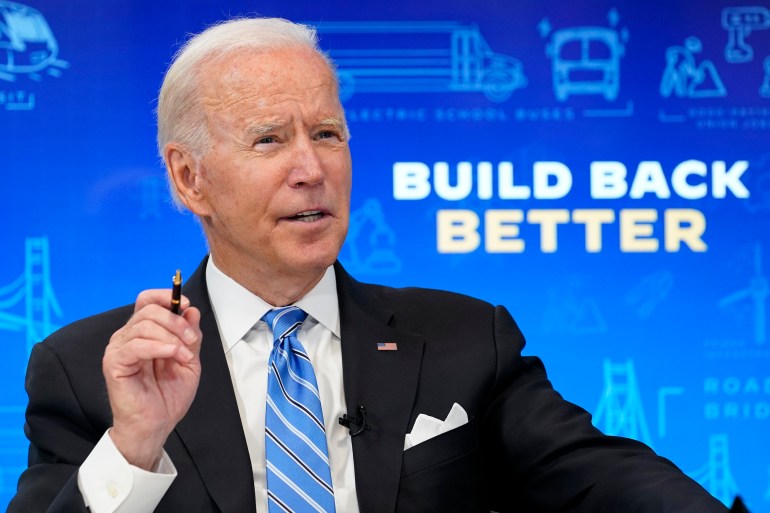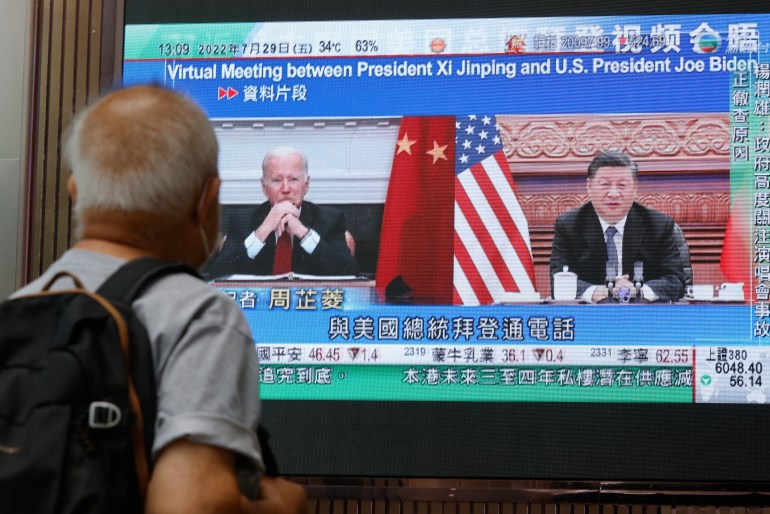Five key moments that shaped Biden’s presidency so far
As Biden announces re-election campaign, Al Jazeera looks at some of the major issues his administration has handled.

Washington, DC – Joe Biden’s record as United States president will weigh heavily on his re-election chances as he seeks a second term in the White House.
At his campaign launch on Tuesday, the 80-year-old president promised to push forward with the policies he started when he first took office early in 2021 and work to heal the “soul of the nation” after the turbulent presidency of Donald Trump.
Keep reading
list of 3 itemsBiden administration to bring abortion pill case to Supreme Court
Biden administration to expand health care for DACA recipients
“I said we are in a battle for the soul of America, and we still are,” Biden said in a three-minute video. “The question we are facing is whether in the years ahead we have more freedom or less freedom. More rights or fewer.”
Biden is positioning his campaign as a contrast with Republican policies he says have become dominated by Trump-like, right-wing hardliners.
But as Biden faces criticism for his stance on the economy and foreign policy, the 2024 vote will likely be a referendum on his first term in office. Here, Al Jazeera looks at five key moments that have shaped Biden’s presidency.
Big spending: Wins and losses
Biden came into the White House with a reputation as a cautious centrist, but he soon unveiled an ambitious $3 trillion plan that would have expanded social safety net programmes and made enormous investments in clean energy, education and housing.
The plan, dubbed Build Back Better, was to be the core of his self-proclaimed agenda to revive the economy “from the bottom up and the middle out”.
The bill was later scaled down to $1.75 trillion in spending, to be spread over 10 years. It was approved by the House of Representatives but was subsequently dropped amid opposition from two conservative Democrats in the Senate, where Biden’s party had a razor-thin margin.

The demise of the Build Back Better plan early in 2022 was a blow for Biden’s agenda. However, in his first years in office, Biden still managed to pass legislation worth trillions of dollars to advance his policies.
In March 2021, Biden signed into law a $1.9 trillion COVID-19 relief bill that included direct payments of $1,400 to most American adults.
Later that year, he also oversaw the passage of a law that designated $1.2 trillion to the country’s physical infrastructure, like roads and bridges. The measure had enjoyed bipartisan support for years. Once it passed, Biden used it to promote his ability to work with Republicans.
Biden signed another big-spending law in August 2022, called the Inflation Reduction Act, a $740bn bill that made funds for healthcare and energy policies.
Afghanistan withdrawal
When Biden came into office, he continued with the plan to pull US troops out of Afghanistan — a 20-year conflict that had turned into Washington’s longest war.
The withdrawal was popular amongst Americans, according to public opinion polls. But the Afghan government quickly collapsed to Taliban forces without putting up a serious fight, something Biden later admitted happened “more quickly than we anticipated”.
After the Taliban takeover of Kabul in August 2021, US troops — confined to the area around the city’s airport until their final withdrawal at the end of the month — oversaw a two-week operation to get desperate Afghans out of the country.
During the evacuation, a suicide bombing by the Afghanistan branch of ISIL (ISIS) killed at least 175 people, including 13 US service members.
The chaotic US exit from Afghanistan, which came about six months into Biden’s first term, subjected the president to a barrage of criticism from Republicans and even some Democrats.

Still, the president vehemently defended his decisions. “I was not going to extend this forever war,” he said in a speech after the last US soldier left Afghanistan.
In a report released earlier this month, US agencies blamed Trump for what they called a lack of planning for the withdrawal despite having agreed to it in a deal with the Taliban in February 2020.
“President Biden’s choices for how to execute a withdrawal from Afghanistan were severely constrained by conditions created by his predecessor,” it read.
Call with Xi Jinping
Weeks after taking office, Biden held a phone call with his Chinese counterpart Xi Jinping, setting a tone for a contentious relationship with Beijing.
A White House statement describing the call said Biden raised several issues with Xi which would go on to become major points of tension between the two countries.
“President Biden affirmed his priorities of protecting the American people’s security, prosperity, health and way of life, and preserving a free and open Indo-Pacific,” the statement said.
“President Biden underscored his fundamental concerns about Beijing’s coercive and unfair economic practices, crackdown in Hong Kong, human rights abuses in Xinjiang, and increasingly assertive actions in the region, including toward Taiwan.”
Biden drew China’s ire later that year when he announced a deal — dubbed AUKUS — with the United Kingdom to supply Australia with nuclear-powered submarines.
The US president also held the first in-person summit with the leaders of the so-called Quad alliance, which includes India, Japan and Australia and is largely seen as a counterweight to China in the Asia-Pacific region.
Last year, Biden again outraged Beijing when he said US forces would defend Taiwan if the self-ruled island were to be invaded by China.
Relations further soured between Washington and Beijing earlier this year when the US shot down what it said was a Chinese surveillance balloon that had traversed North America. China insisted that the aircraft was a weather balloon that had drifted off course.

Despite increasing strains on the US-China relationship, Biden has said repeatedly that he is not seeking a cold war.
However, his approach of treating Beijing as the US’s top geopolitical challenge echoes that of Trump, who initiated a trade war with China.
Defiant midterm performance
The Republican red wave anticipated to sweep the 2022 midterm elections barely made a splash. Instead, Biden’s Democratic Party expanded its Senate majority and only narrowly lost control of the House of Representatives.
One of the defining issues in the election was abortion rights. Less than five months prior, the US Supreme Court had overturned the constitutional right to abortion, a decision that Biden decried as an attack on women’s reproductive freedom.
Protecting abortion access became a central campaign theme for Democrats in key midterm races. Voters in states like Michigan and Kentucky voted down anti-abortion rights measures.
Meanwhile, Republicans focused on inflation, though Biden did not shy away from his economic record ahead of the election. He often touted the 2021 infrastructure law and other investments his administration approved.
After the midterms, Biden pledged to push to unite the US and continue to pursue key elements of his platform.
“The overwhelming majority of the American people support the elements of my economic agenda — from rebuilding America’s roads and bridges, to lowering prescription drug costs, to a historic investment in tackling the climate crisis, to making sure that large corporations begin to pay their fair share in taxes,” he said in a speech days after the vote.
Despite the Democrats’ expectations-defying performance, however, they nevertheless lost their majority in the House. And without the support of Congress’s lower chamber, Biden’s legislative agenda has faced an uphill battle, pushing the president to be increasingly reliant on executive orders.

Kyiv visit, Warsaw speech
Speaking to thousands in Warsaw, Poland, in February, Biden promised that the war in Ukraine “will never be a victory for Russia”.
The speech marked the first anniversary of Russia’s all-out invasion of its neighbour and followed a surprise trip to Kyiv, where Biden met with his Ukrainian counterpart Volodymyr Zelenskyy.
In Warsaw, the US president reasserted Washington’s approach of working to maintain Western unity and ensuring military and humanitarian aid to Kyiv.
“One year after the bombs began to fall and Russian tanks rolled in Ukraine, Ukraine is still independent and free,” Biden said.
“There should be no doubt: Our support for Ukraine will not waver, NATO will not be divided and we will not tire,” Biden told the crowd in the Polish capital.
The Russian military campaign has been marred by setbacks that the Biden administration credits to the strength of Ukrainian resistance as well as Western support to the country.
Biden stressed in February that Russian President Vladimir Putin is failing in Ukraine.
Putin “thought he’d get the Finland-isation of NATO; instead he got the NATO-isation of Finland and Sweden,” Biden said in February, referring to two northern European countries that were formerly neutral but have since pushed to join the US-led alliance.